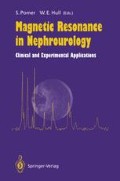Abstract
The application of 31P magnetic resonance (MR) to provide a noninvasive evaluation of renal phosphorus metabolism is well established [7, 13, 14]. In a variety of 31P MR studies of excised or perfused kidneys initial attention has been given to determining the time course of nucleotide (NTP + NDP) depletion (sum of all nucleoside 5’-tri- and diphosphates, primarily ATP and ADP) and intrarenal acidosis during cold and warm ischemia [9]. Within a few minutes depletion of intrarenal NTP was noted, and a rapid onset of acidosis was observed. Previous investigations using low-field 31P MR of the isolated perfused kidney demonstrated sequential changes in phosphate components during ischemia [9]. However, the information provided about the components of different signal groups was insufficient; the renal 31P MR spectra obtained at field strengths lower than 4.7 T did not allow adequate sensitivity and resolution for many of the individual phosphate metabolites, for example, detection of phosphocreatine (PCr), separation of NTP and NDP, resolution of phosphomonoesters (PME) into phosphocholine (PC) and phosphoethanolamine (PE) and of diesters (PDE) into glycerophosphocholine (GPC) and glycerophosphoethanolamine (GPE). Through the use of very high field strengths (>7 T) these problems can be solved, at least for ex vivo studies.
Access this chapter
Tax calculation will be finalised at checkout
Purchases are for personal use only
Preview
Unable to display preview. Download preview PDF.
References
Bretan PN, Vigneron DB, Hricak H, Juenemann K-P, Williams RD, Tanagho EA, James TL (1986) Assessment of renal preservation by phosphorus-31 magnetic resonance spectroscopy: in vivo normothermic blood perfusion. J Urol 136: 1356–1359
Bretan PN Jr, Vigneron DB, James TL, Williams RD, Hricak H, Juenemann K-P, Yen TSB, Tanagho EA (1986) Assessment of renal viability by phosphorus-31 magnetic resonance spectroscopy. J Urol 135: 866–871
Bretan PN Jr, Baldwin N, Novick AC et al. (1989) Pretransplant assessment of renal viability by phosphorus-31 magnetic resonance spectroscopy. Transplantation 48: 48–53
Gonzales-Mendez R, Nabsath DC, Stevenson DK, Goms ML, Schulz TE, Jardetzky O (1989) Renal injury and regeneration in adult rats after total ischemia, MRS correlations. Magn Reson Med Biol 2: 21–32
Hull WE, Pomer S, Vogt P (1987) High-field 31P-NMR analysis of phosphate metabolites in excised rat kidney: assessment of preservation for transplantation. Abstr Soc Magn Reson Med 6: 281
Morris GA, Freeman RA (1978) Selective excitation in Fourier transform NMR. J Magn Reson 29: 433–462
Ross B, Freeman D, Chan L (1986) Contributions of nuclear magnetic resonance to renal biochemistry. Kidney Int 29: 131–141
Seelig J (1978) P-31 NMR and the head group structure of phospholipids in membranes. Biochim Biophys Acta 515: 105–140
Sehr PA, Bore PJ, Papatheofanis J, Radda GK (1979) Non-destructive measurement of metabolites and tissue pH in the kidney by 31P nuclear magnetic resonance. Br J Exp Pathol 60: 632–641
Siegel NJ, Avison MJ, Reilly HF, Alger JR, Shulman RG (1983) Enhanced recovery of renal ATP with post-ischemic infusion of ATP-MgC12 determined by 31P-NMR. Am J Physiol 245: F530–534
Stromski ME, Cooper K, Thulin G, Gaudio GM, Siegal NJ, Shulman RG (1986) Chemical and functional correlates of post-ischemic renal ATP levels. Proc Nail Acad Sci USA 83: 6142–6145
Thoma WJ, Snyder JA, Pearson GA (1989) Broad resonance-edited 31P spectra obtained with a single radiofrequency channel. NMR Biomed 2: 112–114
Weiner MW, Adam WR (1985) MRS for evaluation of renal function. Semin Urol III: 34–42
Wong GG, Ross BD (1983) Application of phosphorus nuclear magnetic resonance to problems of renal physiology and metabolism. Miner Electrolyte Metab 9: 282–289
Author information
Authors and Affiliations
Editor information
Editors and Affiliations
Rights and permissions
Copyright information
© 1993 Springer-Verlag Berlin Heidelberg
About this paper
Cite this paper
Pomer, S., Hull, W.E. (1993). High-Field 31P Magnetic Resonance Studies for Evaluating Kidney Viability. In: Pomer, S., Hull, W.E. (eds) Magnetic Resonance in Nephrourology. Springer, Berlin, Heidelberg. https://doi.org/10.1007/978-3-642-78066-0_12
Download citation
DOI: https://doi.org/10.1007/978-3-642-78066-0_12
Publisher Name: Springer, Berlin, Heidelberg
Print ISBN: 978-3-642-78068-4
Online ISBN: 978-3-642-78066-0
eBook Packages: Springer Book Archive

